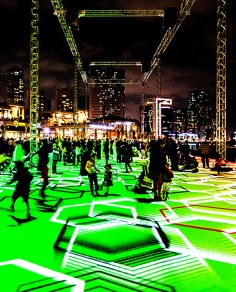miguel chevalier
МИГЕЛЬ ШЕВАЛЬЕ
ミゲル·シュヴァリエ
מיגל שבלייה
미구엘 슈발리에
digital arabesques
source: gerbongartwork
as partial of a 17th islamic art festival in sharjah, french artist miguel chevalier sources oriental patterns and enlightenment to emanate a generative and interactive virtual-reality designation projected on a building of al majaz waterfront. ‘digital arabesques 2014′ revisits a normal art of islam by a middle of digital art, featuring elaborating kaleidoscopic striking scenes referencing to a art of zelliges, arabesques and mosaics and ‘mashrabiya’ latticework.
sophisticated geometrical patterns are driven by mathematical logic, formulating a call that forms and deforms to exhibit a colorful, respirating star that is ceaselessly renewed. as viewers correlate with a piece, they emanate disturbances in a trajectories of these mobile designs underneath their feet, ensuing in an rare interactive and visually immersive experience. the projection on a building of a fountain piazza creates a clear universe of colors and forms with transformation suggestive of a kaleidoscope and mystic of a forever of inlet and creation.
in a art of islam, chevalier detected a musical phenomenon identical to his possess artistic language, as good as a tie with digital algorithmic art in a use of geometry. a artist has extended these facilities by a use of mechanism software, enriching a designs in a fulfilment of his piece.
‘digital arabesques 2014′ outlines a initial truly open civic designation for is chevalier. a 6 video-projectors used are upheld by a constrict structure, but a need for walls or a ceiling, a construction that materializes a new architectural space within a civic landscape.
.
.
.
.
.
.
.
source: digitalarti
Miguel Chevalier was born in Mexico City in 1959. Since 1985, he has been based in Paris, where he does most of his work.
He graduated from the Ecole Nationale Supérieure des Beaux Arts in Paris in 1980 and went on to Ecole Nationale Supérieure des Arts Décoratifs. After graduating in 1983, he was awarded the Lavoisier scholarship by the French Ministry of Foreign Affairs and studied at the Pratt Institute, New York. In 1994, he served as artist in residence at the Kujoyama Villa, Kyoto, Japan.
Miguel Chevalier’s wide-ranging artistic vision has been shaped by a broad education and extensive travel. Since 1982, his art has been dedicated to the exploration of technology. Taking references from the history of art and reformulating them using computer tools, his works investigate the flux and networks that underlie contemporary society. He is known internationally as one of the pioneers of virtual and digital art. His images are a rich source of insights into ourselves and our relationship to the world.
Miguel Chevalier has developed and refined his highly individual approach over the course of numerous solo and group exhibitions throughout the world.
.
.
.
.
.
.
.
source: fundacio-stampfliorg
Nacido en Méjico en 1959. Vive y trabaja en París. Miguel Chevalier se instala en París en 1985 y estudia en la École nationale supérieure des Beaux-arts y en la École des Arts décoratifs. Cursa también una licenciatura en arte y arqueología en la Sorbona y completa su formación en el Pratt Institute y en la School of Visual Art de Nueva York (1984-1985) y en el Instituto des Hautes Études en Arts Plastiques en París (IHEAP). Su primera exposición personal tiene lugar en 1985. Hacia finales de los años ochenta, se convierte en uno de los pioneros del arte numérico. Expone con los Fractalistas, movimiento teorizado por Susan Condé y Henry-François Debailleux.
Desde sus inicios, Miguel Chevalier se consagra a un arte experimental, que tiene en cuenta las innovaciones y las mutaciones tecnológicas. Habla de emplear “las nuevas tecnologías como otros los pinceles. No es una finalidad en sí, sino un medio para vivir en el mundo que nos rodea”. Trabaja con el CNRS y utiliza programas informáticos para crear “desintegraciones” de imágenes que imprime sobre vidrio armado. En su taller piloto de infografía, genera anamorfosis y metamorfosis, reflexiona sobre las nociones de naturaleza y de artificio. Trabaja sobre el movimiento, la luz, el color y realiza dibujos, fotografías, vídeos e imágenes numéricas en tres dimensiones. Sus imágenes son transpuestas en multitud de fragmentos, de híbridos, de combinaciones (series Baroque et classique, 1985; In vitro, 1986). Desde los años 90, concibe instalaciones de vídeo interactivas, en 2D y en 3D a escalas a menudo monumentales (Paysage artificiel, 1992; Pensée numérique, 1997; Croissances et mutations, 1999; Crossborders, 2007). En 2000 realiza Habiter les réseaux para el Palais des Congrès en París, una gigantesca instalación constituida por 24.500 leds rojos que se iluminan, se apagan, parpadean en función de la afluencia de visitantes. Desde 2003 se interesa por las biotecnologías y la genética e imagina obras en perpetua metamorfosis a partir de programas informáticos que crean hibridaciones de plantas mediante algoritmos genéticos. Para Sur-Nature, plantas y flores virtuales, “combinatorias coloreadas de transparencia”, fluorescentes, crecen cada día en tiempo real sobre pantallas-plasma o son proyectadas en el suelo o en las paredes.
.
.
.
.
.
.
.
source: itaucultural
Miguel Chevalier é conhecido como um dos pioneiros da arte digital. Nascido no México e radicado na França, graduou-se na Escola Nacional Superior de Belas Artes , em Paris, no início da década de 1980. Em 1994, ingressou como artista residente na Villa Kujoyama, em Kyoto, Japão.


